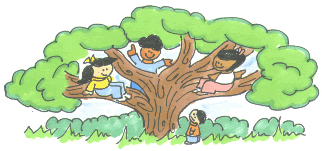
Dealing
with Grief and Loss
By Sophie Maxis &
Teresa Leibforth

Dealing
with Grief and Loss
By Sophie Maxis &
Teresa Leibforth
These interventions are compiled for students in 6th through 8th grades who have recently experienced the death of a loved one. While it is common to think of parents and family members as loved ones, for some students it may also be appropriate to include their pets. The following activities are described for use with groups, however, each activity can easily be modified for use with an individual student. The activities are not presented in a particular order; the counselor can pick and choose which activity speaks to the group or individual at any point in time. This is consistent with the idea that everyone grieves differently and in their own time.
Memory
Bead Necklaces
Adapted
from Helping Teens Work Through Grief by Mary Kelly Perschy
Objectives:
· To help students identify and acknowledge feelings of grief as well as pleasant feelings related to fond memories.
· To promote self-esteem in students through utilization of creative abilities.
Materials Needed:
· Acrylic paints
· Paint brushes
· Beads with holes
· String or yarn
Procedures:
· Ask the students to remember special times and memories they have with the person they have lost. Students can spend a few minutes sharing these memories with the group if they wish.
· Have the students paint and decorate beads to remind them of those special times (for example, one bead could be decorated in a way that reminds the student of a special trip that was taken, another bead could be decorated to remind the student of a holiday spent together).
· Allow students the opportunity to make more than one bead, if desired.
Processing Leads:
· Ask students how they felt as they were working on this activity. Encourage other group members to comment on whether they are hearing pleasant or unpleasant feelings. It may be appropriate to discuss how pleasant and unpleasant feelings can exist at the same time. Linking group members together through similar experiences or feelings can also help to establish cohesiveness within the group.
Recommendations:
· For younger children, it may be helpful to have larger beads to decorate. Alternatively, unique beads could be provided and younger students could choose from these instead of painting their own.
· This activity could also be more structured, if necessary. For example, the counselor could ask students to try to recall more specific events- “Can you think of a time when you were so excited to see your loved one? What was happening at that time?”

Healing
with Music
Adapted
from Helping Teens Work Through Grief by Mary Kelly Perschy
· To provide
students with an alternative way to explore their feelings related to the
loss of a loved one.
· To explore
how different types of music may effect students’ moods.
![]() Materials
Needed:
Materials
Needed:
· Tape or CD
player
· Different
types/styles of music
![]() Procedures:
Procedures:
· Show how different
types of music may have an effect on people’s moods. Play a variety
of music selections and have students write down or draw how they are feeling
after each selection.
· Have students
share with the group their response to the music.
![]() Processing
Leads:
Processing
Leads:
· After the students have identified how the different selections effected them, the counselor could say, “Now that we have seen that music can change our moods, how can we use this information?”. This may be an avenue to discuss how music can be used as a coping strategy to help balance pleasant and unpleasant feelings in daily life.
![]() Recommendations:
Recommendations:
· Perschy cautions that listening to music does not substitute for professional counseling. Students exhibiting symptoms of depression or other affective disorders should be referred to appropriate services.

More
Healing with Music
Adapted
from Grief
Therapeutic Interventions
To help students identify
stages and/or components of grief, stimulate
a discussion about
the complexity of grief as it is manifested through music and provide an
opportunity for values clarification.
![]() Materials:
Materials:
One or more songs about
grief
Tape or CD player
![]() Procedures:
Procedures:
Play the song(s)
Have students identify
the component and /or stages of grief (phases tasks,
meanings) that are
reflected in the song(s)
Explain and Discuss the following comment: Music can open the door to recognize how loss/grief are woven into all aspects of the fabric of the American life.
![]() Procesing
Leads:
Procesing
Leads:
What were some of the feelings you experienced as you listened to the selection(s)?
What parts of the song that were reflected did you find easy/difficult to relate to?
What are some of the aspects of your subculture that you believe make it easier/ more challenging to go through some of the stages that are reflected in the selection(s)?
How has music helped
you in the past with difficult situations?

The Cave
of Fear
Adapted
from Adventures
in the Land of Grief
![]() Objectives:
Objectives:
To help students use creative dramatics to explore feelings of fear and courage during the grief process.
![]() Materials
Needed:
Materials
Needed:
Please refer to The Cave of Fear website. The Cave of Fear activity is copyrighted, but includes a sample script that is free for the public to use. The script includes detailed lists for materials needed, preparation, and procedures.
![]() Processing
Leads:
Processing
Leads:
Depending on the makeup of the group, it may be helpful to first process the experience of acting out the story. Example questions could include: "What was it like for you to participate in this activity?", "How did you feel just before you went behind the big curtain?" and, "How did you feel after you discovered what was behind the curtain?".
Alternatively, the issues of fear, courage, or death could be processed. The counselor could ask, "Can you think of a time when you were afraid, but instead of running away, you had the courage to stay and face your fear?", "You went through the motions of washing away your fears in this activity. Is it that easy to get rid of your fears in real life?" or,"How do you know when someone is courageous? What does courage look like?".
![]() Recommendations:
Recommendations:
Because it would be
very time consuming to go through all of the set-up and decoration for
this activity, it may be beneficial to encourage the students to imagine
the scenario and props.

Who Do You See?: Guided Imagery
![]() Objectives:
Objectives:
To help students identify their feelings and beliefs related to grief and/or loss.
![]() Materials
Needed:
Materials
Needed:
No specific materials, just a quiet area that is free of distractions.
![]() Procedures:
Procedures:
Prepare the students for this guided imagery by taking them through a brief "warm-up" exercise, such as tensing and relaxing different muscle groups.
Ask the students to
close their eyes, and then present them with this scenario:
![]() Processing
Leads:
Processing
Leads:
"Would anyone be willing
to share what they saw?"
"How did you feel
when you saw someone you had been wanting to talk to?"
"How did you feel
when the person disappeared?"
"Has there ever been
another time when you wanted to say something to someone, but couldn't?"
"What are some other
ways to share your feelings?"
![]() Recommendations:
Recommendations:
This activity could
be adapted to be more vague or more specific, depending on the stage and
dynamics of the group. Additionally, this activity may evoke some
strong reactions/emotions and the counselor should be prepared to respond
to these.

References
Perschy, M. K. (1997).
Helping teens work through grief. Washington, DC: Accelerated
Development.
Helpful Web Sites
Healing Magazine: Helping the Grieving Child in School